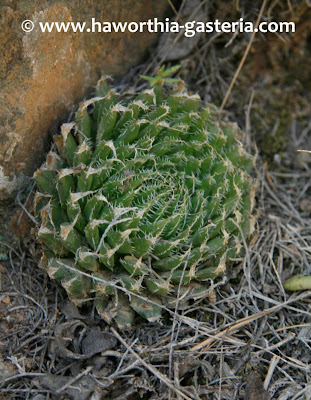 |
| H. mucronata var. calitzensis, Voelfontein, NEW PHOTO |
Haworthia mucronata var. calitzensis (I.Breuer) Hayashi
calitzensis: growing near Calitzdorp
H. mucronata var. calitzensis (previously described as calitzdorpensis) is growing solitary, leaves color is pale yellowish-green, in strong light with a purplish tingle. Margins translucent and toothed, this are also the distinguishing features from typical H. mucronata.
 Distribution map
Distribution map
H. mucronata var. calitzensis is growing on several localities N. and NE. Calitzdorp, very often grows together with H. blackburniae. It grows under the bushes on rocky slopes.
It is moderate difficult species, be cautious when wattering and also do not grow in direct sunlight. Propagation should be done by seeds.
.jpg) |
| H. mucronata var. calitzensis, Voelfontein, NEW PHOTO |
.jpg) |
| H. mucronata var. calitzensis, Voelfontein, NEW PHOTO |
.jpg) |
| H. mucronata var. calitzensis, Voelfontein, NEW PHOTO |
.jpg) |
| H. mucronata var. calitzensis, Kruisrivier, NEW PHOTO |
.jpg) |
| H. mucronata var. calitzensis, Kruisrivier, NEW PHOTO |
.jpg) |
| H. mucronata var. calitzensis, Kruisrivier, NEW PHOTO |
.jpg) |
| H. mucronata var. calitzensis, Kruisrivier, NEW PHOTO |
 |
| Locality of H. mucronata var. calitzensis, Kruisrivier, NEW PHOTO |
Known localities:
- NE. Calitzdorp (3321BD)
- Kruisriver (3321BD)
- Voelfontein, NE. Calitzdorp (3321BD)
.jpg)
.jpg)
.jpg)
.jpg)
.jpg)
.jpg)
.jpg)




2 comments:
Hi Jakub, I am wondering what you think of "rooibergensis" and "crystallina". Do you recognise these in your thinking? Best regards. Kevin
Hi Kevin,
firstly - I´m not 100% sure how "good" name is calitzensis.
May be it should be called H. mucronata 'calitzensis'.
Re crystallina/rooibergensis. that´s element from Rooiberg-Paardebont area. Rooibergensis was originaly described as var. of mucronata, but after several years of observation in cultivation, I agreed with Ingo Breuer, it belogs to cooperi group (same as for example 'erii'), but in the other hand They are far of to the West from normal cooperi area (it finish around Uniondale). I would say They are both very similar to me, I use at the momment name crystallina for them.
But if it is a good species name, that must be decided by somebody else.
Post a Comment